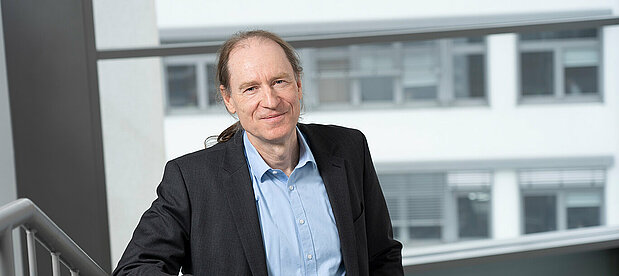


![[Translate to English:] Prüfstelle-Produktprüfung_Teststand Test centre and product testing](/fileadmin/_processed_/0/9/csm_TZW-Karlsruhe_Pruefung_Geraete-Teststand_377188946c.jpg)

















The use of biological decomposition processes in the purification and reuse of waste water and in groundwater recharge makes a significant contribution to sustainable water resource management. TZW develops integrated water supply and waste water management concepts. A focus is on using biological methods to eliminate especially persistent substances in waste water, surface water and groundwater. In addition to these aspects, our risk assessment activities also include evaluating microbial contamination in environmental samples using micro and molecular biological detection methods, for instance for antibiotic-resistant, hygienically relevant and pathogenic microorganisms.
Waste water treatment
Waste water treatment is a key component of water protection. As a result of new challenges in waste water treatment such as microcontaminants that may reach watercourses via waste water treatment plants, TZW contributes to progressing the state of technology and investigating further sewage treatment methods in treatment plants.
Water reuse
One approach to relieving the overstrained groundwater resources in regions where water is scarce, is to enrich groundwater with clarified, treated waste water. TZW is developing innovative concepts to assess possible treatment methods. The entry of combined waste water into surface water is an undesirable intervention in the affected ecosystem. TZW is involved in investigating sustainable and cost-effective approaches to resolve this problem.
SARS-CoV-2 biomarkers
The detection of SARS-CoV-2 biomarkers in wastewater was developed as a new topic. The quantitative detection of RNA contributes to the understanding of the infection process in the context of wastewater-based epidemiology. After a successful establishment of the new methodology, the results are increasingly being integrated into monitoring by local crisis teams.
Risk management
In many locations the quality of the water – whether surface water or groundwater – is at risk or may already be impacted by increasing contamination, extreme weather, accidents and changes in use. Especially with regard to introducing treated waste water or using clarified, treated waste water as a drinking water resource, processes must be evaluated and controlled. Relevant research activities for TZW, therefore, are the establishment, further development, optimisation and validation of micro and molecular biological methods that can help monitor and improve water quality.
Chemical indicators
The evaluation of purification capacity requires the development of sustainable and innovative approaches. Using organic micropollutants as source and process indicators is a highly promising concept for assessing waste water pollution and waste water purification capacity at the catchment area level and is therefore a strategy TZW is pursuing.
Projects
Innovative water reuse for urban irrigation with reclaimed water on the scale of an entire city.
Read moreThe effects of climate change are already evident today resulting in extreme and prolonged dry periods. The use of alternative water resources is thus…
Read moreThe aim of the project was to develop an at-line measurement method for analysing the total zinc content in process waters from steel production and…
Read moreThe technology of managed aquifer recharge (MAR), which has been proven in Germany, was introduced in Peru as a nature-based solution. Its potential…
Read moreThe project consortium pursued the vision of reuse industrial water flows as completely as possible in order to relieve natural water resources. The…
Read moreTZW Publication Series Volume 77: Identifizierung und Bewertung von Eintragsquellen mikrobiologischer Belastungen [Identification and assessment of contamination sources of microbiological pollution]
TZW Publication Series Volume 62: Elimination anthropogener organischer Spurenstoffe im Zuge der Grundwasseranreicherung [Elimination of anthropogenic organic micropollutants during groundwater enrichment]
Volumes from the TZW publication series can be purchased here.
Schmidt N., Page D., Tiehm A.: Biodegradation of pharmaceuticals and endocrine disruptors with oxygen, nitrate, manganese (IV), iron (III) and sulfate as electron acceptors. Journal of Contaminant Hydrology 203: 62-69 (2017) DOI 10.1016/j.jconhyd.2017.06.007
Scheurer, M., Nödler, K., Freeling, F., Janda, J., Happel, O., Riegel, M., Müller, U., Storck, F.R., Fleig, M., Lange, F.T., Brunsch, A., Brauch, H.-J. (2017): Small, mobile, persistent: Trifluoroacetate in the water cycle - Overlooked sources, pathways, and consequences for drinking water supply. Water Research: 126, 460-471
Schneider A.-L., Schell H., Hild S., Mangold K.-M., Tiehm A.: Studies into design and operation of microbial fuel cells using oxygen gas diffusion electrodes. Desalination and Water Treatment 91: 222-227 (2017) DOI 10.5004/dwt.2017.20558
Castronovo, S., Wick, A., Scheurer, M., Nödler, K., Schulz, M., Ternes, T. A. (2017): Biodegradation of the artificial sweetener acesulfame in biological wastewater treatment and sandfilters. Water Research: 110, 342-353
Nödler, K., Tsakiri, M., Aloupi, M., Gatidou, G., Stasinakis, A.S., Licha, T. (2016): Evaluation of polar organic micropollutants as indicators for wastewater-related coastal water quality impairment. Environmental Pollution: 211, 282-290
Ho J., Seidel M., Niessner R., Eggert J., Tiehm A.: Long amplicon (LA)-qPCR for the discrimination of infectious and noninfectious phiX174 bacteriophages after UV inactivation.
Water Research 103: 141-148 (2016) DOI 10.1016/j.watres.2016.07.032
Schmidt K.R., aus der Beek T., Dai X., Dong B., Dopp E., Eichinger F., Hammers-Wirtz M., Haußmann R., Holbach A., Hollert H., Illgen M., Jiang X., Koehler J., Koester S., Korth A., Kueppers S., Li A., Lohmann M., Moldaenke C., Norra S., Qin B., Qin Y., Reese M., Riehle E., Santiago-Schuebel B., Schaefer C., Simon A., Song Y., Staaks C., Steinhardt J., Subklew G., Tao T., Wu T., Yin D., Zhao F., Zheng B., Zhou M., Zou H., Zuo J.,Tiehm A.:Since 2015 the SinoGerman research project SIGN supports water quality improvement in the Taihu region, China. Environmental Sciences Europe 28(1): 1-6 (2016) DOI 10.1186/s12302-016-0092-7
Jekel, M., Dott W., Bergmann, A., Dünnbier, U., Gnirß, R., Haist-Gulde, B., Hamscher, G., Letzel, M., Licha, T., Lyko, S., Miehe, U., Sacher, F., Scheurer, M., Schmidt, C. K., Reemtsma, T., Ruhl, A.S. (2015) Selection of organic process and source indicator substances for the anthropogenically influenced water cycle. Chemosphere: 125, 155-67
Scheurer, M., Heß, S., Lüddeke, F., Sacher, F., Güde, H., Löffler, H., Gallert, C. (2015) Removal of micropollutants, facultative pathogenic and antibiotic resistant bacteria in a full-scale retention soil filter receiving combined sewer overflow. Environmental Science: Processes & Impacts 17 (1), 186-196
Contact


List of publications
Publication list relating to waste water and the water cycle